The burial jar, found under the floor of a mountaintop citadel called La Almoloya in southeastern Spain, held a puzzle. Almost 1 meter in diameter, the vessel entombed a woman in her late 20s with a shining silver diadem on her forehead. She also had silver earplugs threaded through with silver hoops, an awl covered in silver—and a companion: a middle-age man laid to rest in the same jar with a fraction of her wealth. The pair were likely prominent members of a Bronze Age protostate called El Argar, which dominated much of the Iberian Peninsula from hilltop strongholds for nearly 700 years, beginning around 2200 B.C.E.
When archaeologists first excavated these tombs more than a century ago and found many women and men buried together in large jars, they assumed the pairs were royal couples. But given the wealth gap between women and men, later researchers concluded the jars held relatives who died years apart. They thought the women’s rich adornments suggested a matriarchy, where powerful women were buried and their sons or grandsons added to their tombs later.
Then, in 2019, a team of geneticists and archaeologists extracted DNA from the La Almoloya woman and her companion, along with 66 other people buried in pairs and singly in the walls and under floors of the hilltop houses. Rather than ancestors and descendants, the analysis showed, the couples were partners. In three cases, children were buried near their parents, who were buried together; one baby girl was the daughter of the woman and man buried in the palace. “We did not expect that,” says co-author Roberto Risch, an archaeologist at the Autonomous University of Barcelona. “But [the couples] must have been contemporary, because they had offspring together.”
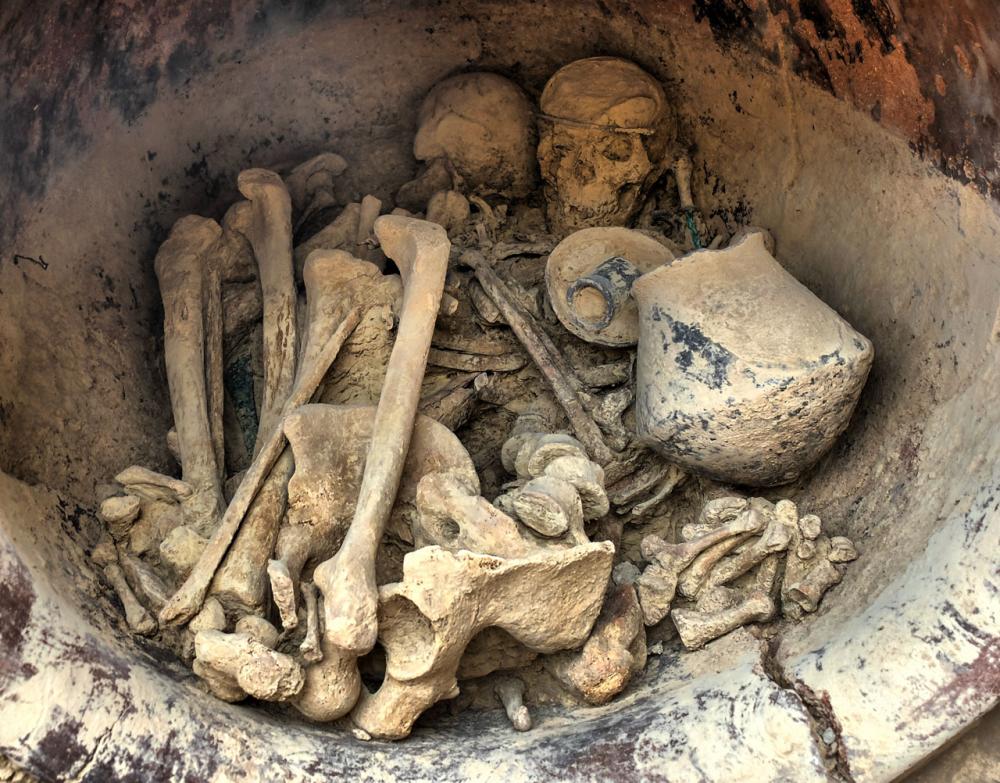
DNA revealed the puzzling connection between a woman and man buried together in a jar at La Almoloya, a Bronze Age fortress in Spain. AUTONOMOUS UNIVERSITY OF BARCELONA
The results also revealed that the elite women seemed to be transplants, perhaps from other high-status hilltop settlements. Unrelated to others buried at the site, the women married men who were related to each other and apparently local, perhaps as a way to knit far-flung El Argar settlements into a cohesive early state. “Probably women were crucial in social networking,” Risch says. “It’s clear the culture’s protagonists are women.”
The results from La Almoloya, published last year, are part of a surge of new studies that are shifting the focus of ancient DNA research from genetic links between populations toward intimate, interpersonal connections. As the cost of DNA sequencing has plummeted, researchers have started to sequence genomes from many people at a site, revealing the structure of ancient communities. “It’s gotten so cheap that you can do whole cemeteries,” says computational biologist Harald Ringbauer of the Max Planck Institute for Evolutionary Anthropology (EVA). Combined with more traditional archaeological data, this tsunami of ancient DNA promises unprecedented insights into prehistoric family practices, group identity, and power. “We can infer not only biological kinship, but social practices,” says geneticist Vanessa Villalba-Mouco of EVA. “We can understand marriages, maybe, in the past.”
Already, geneticists and archaeologists have teamed up to dissect the marriage patterns of Bronze Age steppe nomads and traced thousands of living descendants of enslaved women buried 200 years ago in a forgotten Maryland cemetery. Forthcoming ancient family trees, presented at two recent conferences and as preprints, promise to reveal not just siblings and parent-child relationships, but distant cousins 10 degrees removed, such as at an Iron Age English site where the burials of 170 relatives spanning 10 generations are grouped by maternal ancestry. At the International Society for Biomolecular Archaeology meeting last month, researchers reported tracing kinship ties among hundreds of people from a remote Polynesian island, showing that millennia-old social practices on the island shifted along with new arrivals.
“There’s extraordinarily exciting stuff happening, and it’s not just geneticists who are excited about it,” says Australia National University archaeologist Catherine Frieman. “We’re finally at a point where you can actually ask archaeological questions about this data,” like how people in the past organized societies and venerated ancestors.
The field “is really blooming,” agrees Zuzana Hofmanová, an EVA geneticist who is working on reconstructing the social structure of medieval Moravia using the bones of people buried under Czech and Slovak churches. “We’re just scratching the surface. There’s a lot to be done, and it’s really fun.”
AFTER THE FIRST COMPLETE ancient human genome was published in 2010, demonstrating the power of ancient DNA technology, a wave of studies mapped ancient migrations and population shifts. The work drew on samples widely scattered in time and space, because sequencing ancient genomes was at first so expensive that researchers often sampled just one or two individuals per site. Geneticists focused on broad patterns of similarity in the DNA, and archaeologists seeking fine-grained analyses of social structure and culture were sometimes sidelined. “We told stories from a biological perspective that were only indirectly related to actual history,” says Joachim Burger, a geneticist at Johannes Gutenberg University Mainz. “Archaeologists always hated us for that, and they’re absolutely right.”
Today, sequencing can be done at a fraction of what it cost a decade ago, and often yields more information per sample. Researchers can analyze well-preserved DNA from an ear bone for as little as a few hundred dollars—about the same price as getting a radiocarbon date. Based on shared stretches of DNA, studies can identify siblings and link grandparents to grandchildren, tracing the chronology of a cemetery in a way traditional radiocarbon dating, accurate to several decades at most, cannot. “We often tell archaeologists to wait and do radiocarbon dating after we put together the pedigree,” says University of the Basque Country geneticist Iñigo Olalde.
In the early days of ancient DNA, such kinship information was considered noise. As a Ph.D. student in 2015, Olalde recalls working out a way to identify first-degree relationships among ancient individuals—in order to weed siblings and parents out of his data sets. “If you want to understand how people move, you want as many unrelated individuals as possible. A family is just the same DNA all over again,” Olalde says. “We weren’t particularly interested in families.”
He was surprised to find archaeologists felt differently. As ancient DNA technology improved, “we realized there was a lot of potential … it wasn’t just father-son, or a couple of siblings,” he says. “It was whole families, over multiple generations.” Soon, he was partnering with archaeologists to spin samples originally gathered for sprawling population studies into papers focused on prehistoric kinship.
IN THE LATE 1970S, dozens of skeletons were found under a 50-meter-long barrow called Hazleton North, built 5700 years ago by some of the earliest farmers in Great Britain—part of the same population that began to construct Stonehenge 700 years later. For decades, archaeologists wondered whether Hazleton and similar mounds were like family crypts or functioned more as shared shrines, collecting biologically unrelated members of the community.
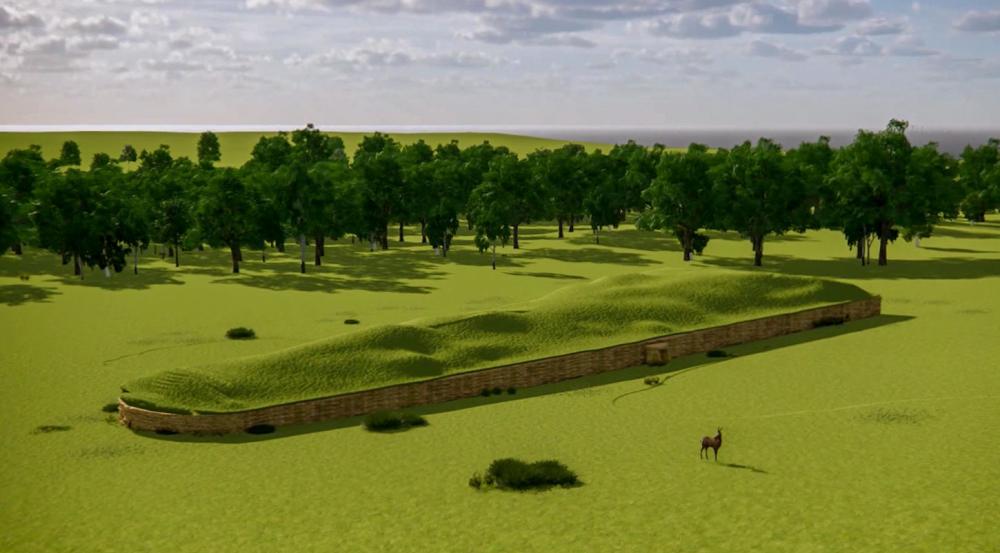
A reconstruction of the 5700-year-old Hazleton North barrow in England, in which dozens of family members were buried over generations.CORINIUM MUSEUM © COTSWOLD DISTRICT COUNCIL
DNA from the tomb has now provided clear answers: Hazleton was a family affair. Working with a team that included Newcastle University archaeologist Chris Fowler, Olalde showed the tomb contained 27 relatives spanning five generations, as well as seven unrelated people. Fifteen of the men in the tomb were related by descent to a single man, whereas none of the adult women were. Although the family tree included two young girls, adult women descended from the founder were conspicuously missing (see graphic, below).
That suggests that among these Neolithic Britons, women were buried with the family of their mates, not their parents—an echo of arrangements in the later El Argar culture that opens the possibility that the people at Hazleton were patrilocal, too. “In the absence of genetics, we just couldn’t tell,” Fowler says. Now, “We can combine biological sex with what we know about age to see that socially this was something significant.” Archaeologists had speculated about patrilocality in past societies based on ethnographic evidence and clues from bone chemistry, but had never been able to conclusively demonstrate it. Fowler hopes studies of isotopes in the bones, which can serve as a geographic fingergprint, can show how those men and women moved during their lifetimes.
Even though the women at Hazleton were unrelated, they apparently helped structure the extended families. The family’s founding father had four female partners. They were apparently from different generations, because a later woman in the tomb had children with the founder’s son as well as his grandson by a different partner, suggesting the son and grandson were somewhat similar in age. So the team guesses the founder’s four unions were sequential, spread over his lifetime.
Over the course of a century or more, burials were organized according to the female line. Two women and their descendants were buried in the tomb’s southern chamber, whereas offspring of the other women were buried in a separate passage on the other side of the mound. “When you look at the layout … it seems to really matter which of those first generation women you were related to, and it seems to have been followed for five generations,” Fowler says. “That male lineage unifies the tomb, whereas female ancestors subdivide the community.”
A Neolithic family affair
The complex family tree of a Neolithic clan buried in a chambered tomb called Hazleton North shows the promise of DNA to reveal ancient relationships. The founder was one male; shades of blue indicate his descendants with each of four female partners. The tomb holds many of his male descendants, along with their young children of both sexes (smaller symbols). Adult daughters are missing, presumably buried elsewhere. One third generation male descended from the founder on both sides.

D. AN-PHAM/SCIENCE
This summer, the longest and largest pedigree yet was published, from a Neolithic site in France called Gurgy ‘les Noisats,’ where nearly 100 individuals have been sequenced. The site predates Hazleton by 1000 years, and it provides strong evidence for patrilocality: Dozens of people over seven generations traced their descent back to one man. To date, most of the dozen or so prehistoric family trees from Neolithic and Bronze Age Europe suggest patrilocality. “It’s surprising how consistent it’s been,” given the variety of social structures seen in recent societies, says Ian Armit, an archaeologist at the University of York who wasn’t part of the Gurgy team.
Others caution that a handful of studies from a 5000-year period across Europe isn’t enough to show patrilocality was a rule. “We’re still looking at single-site studies that don’t allow us to draw strong conclusions,” says Wolfgang Haak, a geneticist at EVA.
Some DNA from Gurgy posed riddles. There were no half-siblings, strange at a time when people died early and partners could have taken another mate. The absence suggests an avoidance of even serial partners, says Ghent University geneticist Maïté Rivollat. “Maybe they had rules we don’t know about in terms of who was buried there, or maybe they were strictly monogamous.”
At Gurgy, the team also did a new kind of analysis, adapting a technique commonly used by commercial ancestry testing companies to identify distant cousins. Called “identical by descent,” or IBD, analysis, it compares the frequency and length of identical stretches of DNA to find more distant relatives. Standard ancient DNA analysis can connect people two degrees apart at most—a grandmother to her grandson, for example. IBD analysis allows geneticists to trace distant cousins, great-great-grandparents, or beyond.
IBD analysis showed how women influenced Gurgy’s patrilocal community. “We see one woman leaves the community and a couple of generations later her descendants come back in,” Ringbauer says. For example, a woman who had no daughter buried in the cemetery did have maternal descendants buried there. The missing female relatives must have left and borne offspring elsewhere; those offspring’s descendants later returned and were buried at Gurgy. That suggests women stayed connected to their home village or birth family as part of a larger regional network.
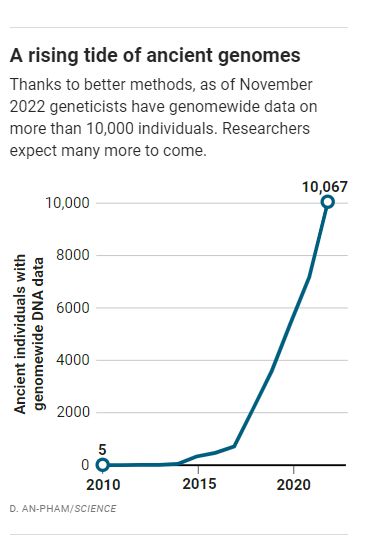
Researchers are beginning to apply IBD to other sites and time periods. In a recent preprint, for example, Ringbauer identified second cousins who were buried 5000 years ago—and 1400 kilometers apart—in southern Russia and central Mongolia. Both men were members of the Afanasievo culture, an eastern variant of the steppe Yamnaya people who made a major genetic contribution to European populations around that time. At least one of the cousins must have traveled hundreds of kilometers across the steppe during his life, an early example of dramatic mobility in the space of a few generations.
As ancient DNA databases grow exponentially, Ringbauer hopes access to tens of thousands of published genomes will create a sort of 23andMe for the distant past, linking prehistoric people to one another across time and space. “We can now screen tens of thousands of ancient individuals for IBD,” Ringbauer says. “My vision is you’d add a study and immediately see, ‘Oh, there’s a second cousin over there.’”
PERHAPS CHASTENED by past criticisms, geneticists are now quick to concede that biological relatedness is only one element of kinship. Ethnographic studies of recent societies are rich in examples of biological parentage taking a back seat to other kinds of family relationships. They include matrilineal systems in which the most significant male relative is the mother’s brother and communities where fatherhood is determined by the transfer of cattle to a woman’s family. “Kinship is not just genetically determined, it’s socially constructed,” says Joanna Bruck, a University College Dublin archaeologist. “There has to be an acknowledgement that genetics can be read in multiple ways.”
Archaeology can help guide those readings, as an early study of biological relatedness showed. It scrutinized the genomes of 84 people buried in small cemeteries up and down Germany’s narrow, fertile Lech Valley between 2500 B.C.E. and 1650 B.C.E., during the technological transition from Neolithic farming to the Bronze Age. Published in 2017, the results showed patrilocality. But many Lech Valley cemeteries included both biologically related individuals and those with no genetic links to others in the graveyard.
Material culture helped explain the pattern. The unrelated people had many fewer grave goods, says Alissa Mittnik, a geneticist at EVA who co-authored the study. “The farmsteads were probably run by families who accumulated wealth. The others might have been farm workers, servants, or enslaved people.” Those people did not establish families in one place across generations, but were buried in the plots of the presumably wealthier landowners, who did.
To puzzle out such community relationships, geneticists and archaeologists are forging stronger ties. For example, when Ludwig Maximilian University of Munich archaeologist Philipp Stockhammer, a lead author on the Lech Valley paper, was awarded a European Research Council grant to look for kinship patterns in Bronze Age Greece and the Aegean, his first step was to reach out to Greek archaeologists, asking for sites and questions where DNA could contribute. “Kinship analysis forces every lab to work closer with local archaeologists,” Stockhammer says. “You can’t do without archaeologists anymore.”
Earlier this year, Stockhammer’s team found that one-third of its samples from another Aegean project had long stretches of shared DNA, indicating they were the offspring of first cousins. That rate of close-kin interbreeding is highest documented anywhere in the past, although some modern societies have similarly high levels of cousin marriage.
Although the practice was slightly more frequent on isolated islands, it was seen across the Aegean, suggesting it was the result of a social practice or choice, rather than a lack of potential partners.
“Why do you have long-distance mobility of marriage partners in Central Europe in the Bronze Age, but not in Greece?” Stockhammer asks. Culture may hold an answer: The Bronze Age people of the Aegean grew olives and grapes. Those crops take decades to establish, offering an incentive to keep land in the family. “This kind of data lets us see how certain practices compare across regions,” Stockhammer says. “The future of archaeogenetics is going to be zooming in, and then zooming out.”
Paleogeneticists also hope to broaden their work beyond Europe, where research has flourished thanks to adequate funding, access to samples, and good preservation in the continent’s relatively cool caves and burials. (See a review of research outside of Europe.) The work could also inform modern medicine, if researchers can identify a genetically inherited disease and trace it back generations. “Pedigree studies on modern individuals have been useful in tracing rare variants and how they’re inherited,” Hofmanová says. “Nine generation pedigrees from the past—and soon longer—will enable you to trace rare variants much further than we can in modern individuals.”
In 2008, Haak was one of the first to apply ancient DNA to identify parents and children in a central German grave. Fifteen years later, the scope of information that DNA can reveal about life in the past is rapidly widening. “The question when you approach every grave is: Who are they? Are they related? Does proximity in space mean kinship?” Haak says. “Getting closer to answering some of those questions is a long-held dream that came true.”
Andrew Curry is an award-winning journalist with more than 20 years of experience reporting from five continents covering science, travel, history, politics, cycling and more. He has for a wide variety of publications, from Architect and Bicycling to National Geographic, The New York Times, Rouleur, and Wired. I am a contributing correspondent for Science and a contributing editor at Archaeology. Andrew Curry lives in Berlin, Germany.
Science has been at the center of important scientific discovery since its founding in 1880—with seed money from Thomas Edison. Today, Science continues to publish the very best in research across the sciences, with articles that consistently rank among the most cited in the world. In the last half century alone, Science published:
- The entire human genome for the first time
- Never-before seen images of the Martian surface
- The first studies tying AIDS to human immunodeficiency virus
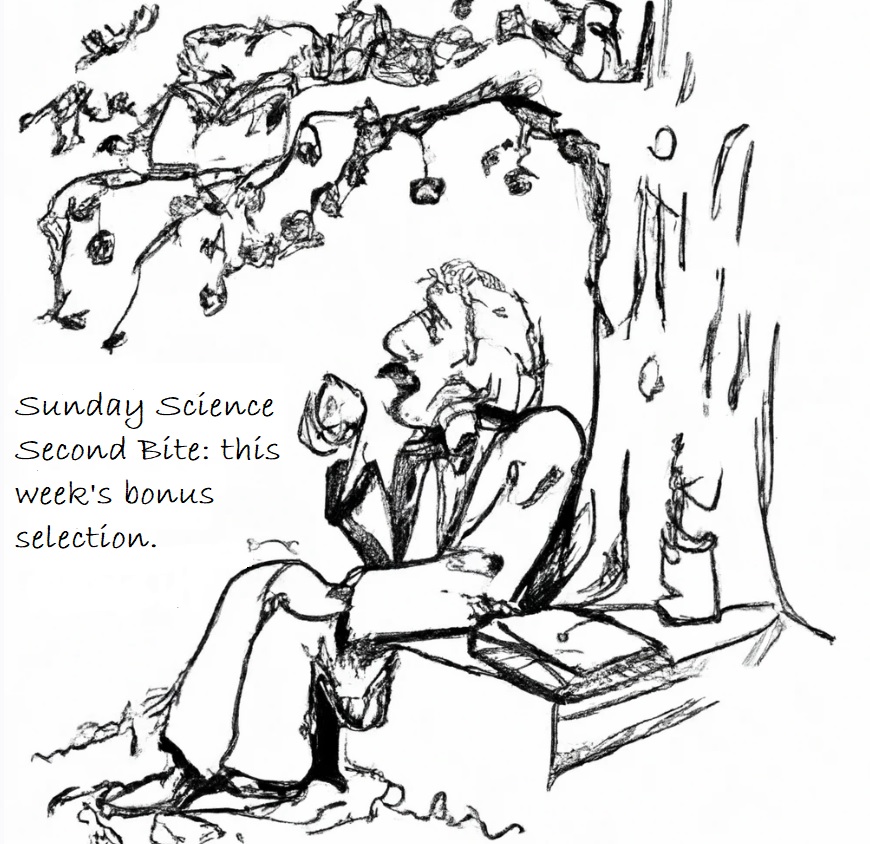
Warp Drive’s Best Hope Dies, as Antimatter Falls Down
In the quest to measure how antimatter falls, the possibility that it fell "up" provided hope for warp drive. Here's how it all fell apart.
Ethan Siegel
Starts with a Bang October 3, 2023

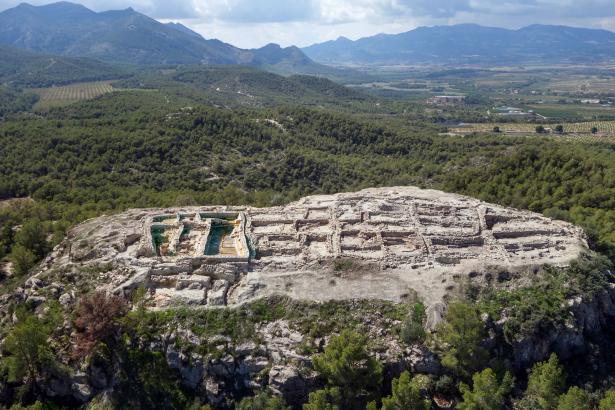
Spread the word